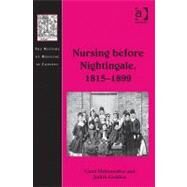Nursing before Nightingale, 1815û1899
, by Helmstadter,Carol- ISBN: 9781409423133 | 1409423131
- Cover: Hardcover
- Copyright: 11/28/2011
Nursing Before Nightingale is a study of the transformation of nursing in England from the beginning of the nineteenth century until the emergence of the Nightingale nurse as the standard model in the 1890s. From the nineteenth century on historians have considered Florence Nightingale, with her training school established at St. Thomas's Hospital in 1860, the founder of modern nursing. This book investigates two major earlier reforms in nursing: a doctor-driven reform which came to be called the 'ward system,' and the reforms of the Anglican Sisters, known as the 'central system' of nursing. Rather than being the beginning of nursing reform, Nightingale nursing was the culmination of these two earlier reforms.Recent historians of nursing have ascribed the nineteenth century makeover of nursing to two causes: medicalization by hospital doctors who found the old independent nurse practitioners a threat, and the inculcation of middle class values by philanthropists. By contrast this volume demonstrates that the real cause of nursing reform was the development of the new scientific medicine which emphasized supportive therapeutics and, as a result, became heavily dependent on skilled nursing for successful implementation of these treatments. The pre-industrial work ethic of the old hospital nurses could not meet the requirements of the new medicine. Recruitment and retention of working-class persons was also extremely difficult because nursing in the early nineteenth century formed the lowest rung of the occupation of domestic service and was a job of last resort. It was still more difficult to recruit educated women or 'ladies.' There were intricate interactions between the requirements of clinical nursing under hospital medicine's new regime on the one hand, and on the other, the contemporary ideal of a lady, class structure, economic realities, the reformation of manners, and the detrimental impact of violent denominational controversies in a very religious society. This book, therefore, will be of great value to those studying the history of medicine, labour, religion, gender studies and the rise of a respectable society in the nineteenth century.







